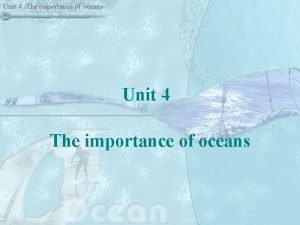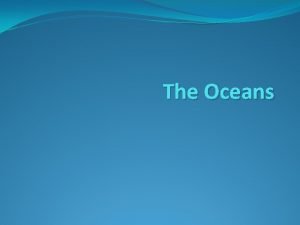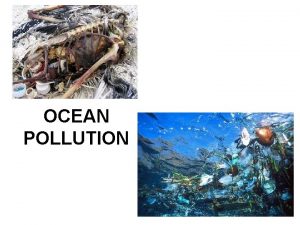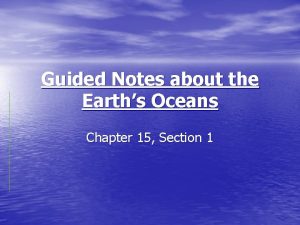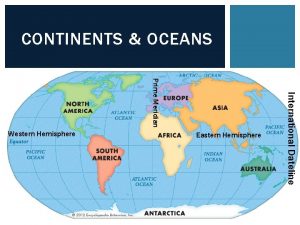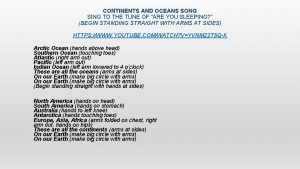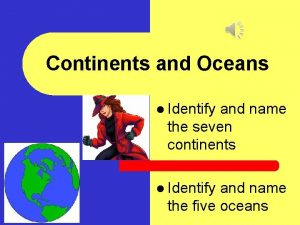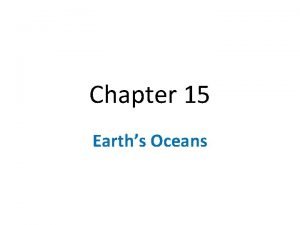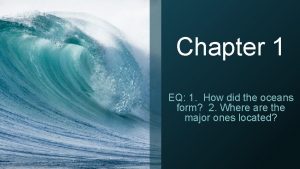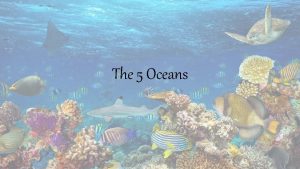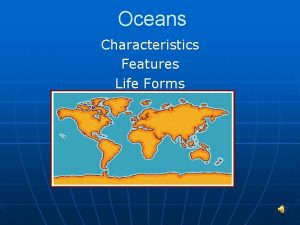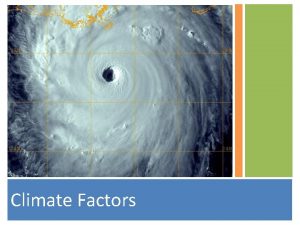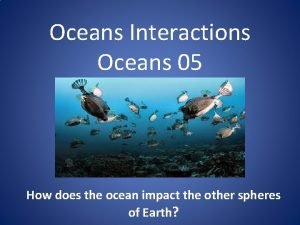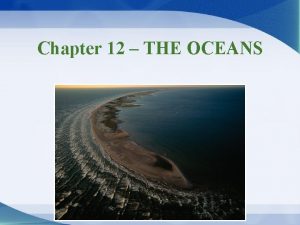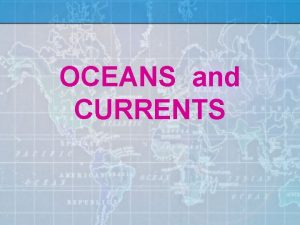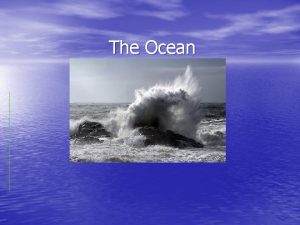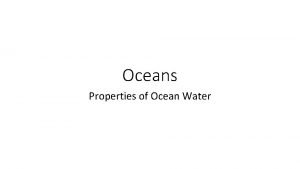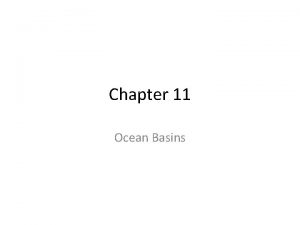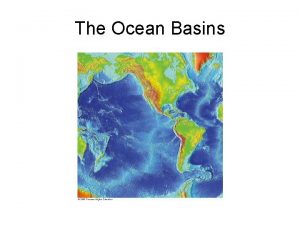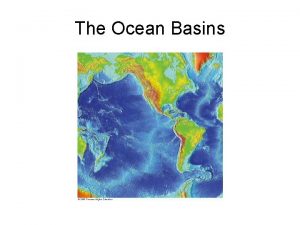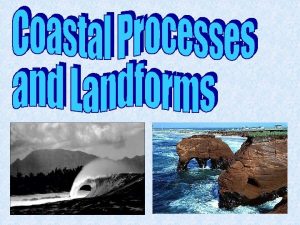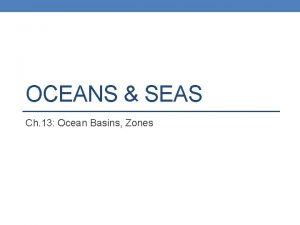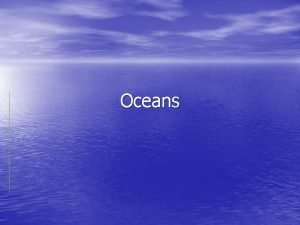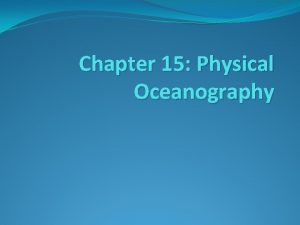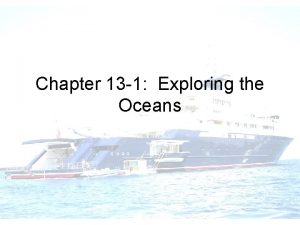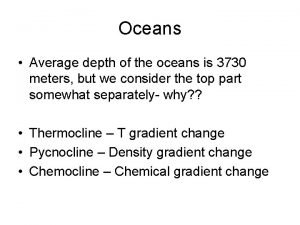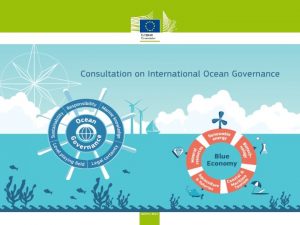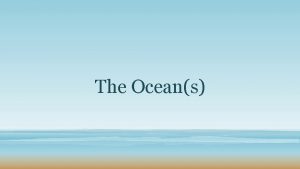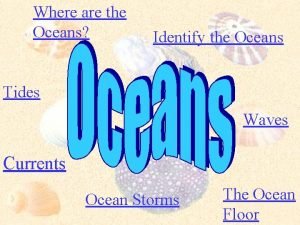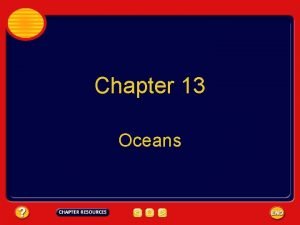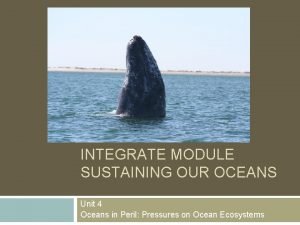OCEAN ENERGY Topics Ocean Energy Energy from Oceans




























- Slides: 28

OCEAN ENERGY

Topics - Ocean Energy Ø Energy from Oceans (OTEC, Wave, Hydro, Tidal) Ø Efficiency & Types of OTEC (Open, Closed, Hybrid) Ø Ocean Waves: Potential, Progressive Wave Motion, Power Density Ø Devices that Convert Ocean Wave to Energy Ø Ocean Wave Power Plants Ø Tidal Energy, Its Potential Ø Types of Tidal Power Plants (Single-Pool, Modulated, Two-Pool) Ø Tidal Energy Power Plants Ø Cost of Ocean & Tidal Power Ø Benefits from Ocean & Tidal Energy Ø Environmental Impact & Risks

Energy from the Oceans • Hydro power – solar heating evaporates water from the surface of the oceans, form clouds, condenses as rain, falls over land, causes rivers to flows to feed dams that generate electricity • Wave energy – winds generate large ocean waves that can be used to generate power from its potential and kinetic energy. • Ocean temperature energy conversion (OTEC) – temperature gradient between the surface and bottom of the ocean can be utilized in a heat engine to generate power • Tidal energy – caused by lunar and solar gravitational forces acting together with that from the earth on the ocean waters to create tidal flows manifested by the rise and fall of waters that vary daily and seasonally from a few centimeters up to 8 -10 meters in some parts of the world. The potential energy of the tides is tapped to generate power.

Types of OTEC Systems • Claude, open-cycle system actually boils the seawater by operating at low pressures. This produces steam that passes through a turbo-generator to produce electricity. • Controlled flash evaporator open-cycle system has been used in the cogeneration of electricity and fresh water; water violently flashes upon depressurization; flashed steam drives generator; condensed steam is recovered as fresh water. • Anderson, closed-cycle system uses the ocean's warm surface water to vaporize a working fluid, which has a low-boiling point, such as ammonia; vapor expands and turns a turbo-generator. • Hybrid systems combine both closed-cycle and open-cycle systems.

Ocean Waves – Its Potential Wave energy is caused by wind passing over water; it is a stored form of solar energy. Estimates put a total of 2 -3 TW (million MW) of energy could be harnessed from waves – about twice the world’s electricity production. Coastlines with an ocean fetch of > 400 km are suitable; greater waves are found between 30 and 60 deg latitudes in both hemispheres. With less than 0. 1% of wave energy converted to electricity, we could supply more than 5 times the world’s demand for energy. Wave energy density can average 65 MW per mile of coastline.

Progressive Wave Motion

Devices that Convert Wave Energy • Floats or pitching devices – generate electricity from the bobbing or pitching (up and down) action of a floating object that is mounted to a floating raft or to a device fixed on the ocean floor. • Oscillating water columns (OWC) – generate electricity from the rising and falling of a water column in a cylindrical shaft that drives air into and out of the top of the shaft, powering an air-driven turbine that turns continuously in one direction. • Wave surge or focusing devices – shoreline devices called “tapered channel” or “tapchan” systems that concentrate the waves, driving them into an elevated reservoir where its potential energy is used to generated electricity using standard hydropower technologies like the dam.

Float Wave-Power Reciprocating motion is converted to mechanical, then to electrical power. Optimum system has power density of 0. 5 k. W/m 2. Dolphin type with connecting rod and multiple pontoon raft could generate 2 MW/raft.

Oscillating Water Column Principle Wave energy collectors used in Limpet and Osprey modules are partially submerged shells into which seawater is free to enter and leave; water level rises or falls in sympathy; column of air above water level is alternately compressed and decompressed, generating a high velocity air going in and out of an exit blowhole; energy extracted thru a pneumatic (air) turbine.

Oscillating Water Column (OWC) Wells Turbine Prof. Alan Well’s turbine (founder of Wavegen) has the unique property of turning in the same direction regardless of which way the air is flowing across the turbine blades, thus continue turning on both the rise and fall of wave levels within the collector chamber.

Oscillating Water Column (OWC) LIMPET is OWC with Wells pneumatic turbine generator. LIMPET generates 500 k. W, uses inverter drive for high turbine efficiency, 60 -year service life, connected to UK’s national grid with a 15 -year PPA, costs 1 million pounds, and provides power to 400 island homes. Overall efficiency of up to 40% under ideal oscillating flow with the use of intelligent controller for varying rotor resistances.

Hydraulic Accumulator • Instead of air, water is pressurized and stored or pumped to a high-level reservoir, from which it flows thru a water turbine driving a generator. • A 500 -k. W prototype was built in Germany for powering a navigation buoy.

High-Level Reservoir • A similar pressure magnification piston is used, but the pressurized water is elevated to a natural reservoir above the wave generator. • Water in the reservoir flows thru a turbine back to sea level. • A 20 -m diameter of this type can produce 1 MW.

Dam-Atoll Concept The dam-atoll concept was developed by Lockheed; based on the principle of dams and atolls: as waves approach atolls (small volcanic islands), the waves wrap themselves around the atolls from all sides, ending in a spiral in the center, driving a turbine before discharging laterally outward; a module 80 m in diameter and 20 m high could generate 1 -1. 5 MW during 7 -10 s period waves.

Tapered Channel & Pendulor Tapered channel -“tapchan” comprises a gradually narrowing channel with wall heights of 3 -5 m above mean water level; wave height is amplified by narrow channel until wave crests spill over the walls to a reservoir for a conventional low head turbine. Pendulor device is a rectangular box which is open to the sea at one end; pendulum flap is hinged over this opening so that it swings back and forth to power a hydraulic pump and generator.

Ocean Wave Power Plants

Environmental Impact and Benefits • Hydrodynamic environment – devices could act as coastal protection and change the flow patterns of sediment, require sensitive site selection • Artificial habitats – devices could attract and promote populations of various marine creatures • Noise – comes primarily from the Wells turbine of shoreline OWC, needs to be sound-proofed • Navigation hazards – adequate visual and radar warning devices can be built into most devices to warn marine traffic. • Visual effects – view of shoreline could be affected • Leisure amenity – devices could provide calm waters when used as breakwaters, thereby promoting some water sports like canoeing and scuba diving • Conversion and transmission of energy – there may be visual and environmental impacts associated with the transmission line to shore/grid. • Emissions – no emissions of CO 2, SO 2, NOX and particulates during operation but some during construction (6840 kg CO 2, 67 kg SO 2, 28 kg NOX per TJ).

Tidal Energy Tidal energy arises from cyclic tidal currents and tidal rise and fall of oceans , which are caused by the earth’s rotation and its interaction with the sun and moon’s gravity.

Tidal Energy Resource • Tidal schedules vary from day to day because the orbit of the moon does not occur on a regular 24 -h schedule; the moon rotates around the earth every 24 h, 50 min. • Tidal range (high tide – low tide) vary from one location to another due to local shoreline conditions and water depth. When favorable, resonance effect causes very large tidal ranges. The Bay of Fundy in Maine has a huge range of 20 m. • Total tidal power that is dissipated throughout the world is estimated at 2. 4 x 106 MW, or 1/3 of the world’s consumption. Of this, around 1. 0 x 106 MW are dissipated in shallow seas and coastal areas and are not recoverable.

Single-Pool Tidal System Single-pool tidal system has one pool or basin behind a dam that is filled from the ocean at high tide and emptied at low tide. Flow of water in both directions drive reversible water turbines. During each tidal period of 12 h, 25 min, two short generation periods once every 6 h, 12. 5 min (22, 350 s) occur. The average theoretical power is: Pav = (1 / 2) (g / gc) ρ A R 2 / 22350 = 0. 225 R 2 W/m 2 Actual power output would be less since the turbines and generators are only 25 -30% efficient. The power generated is immense: Bay of Fundy with an area of 13, 000 km 2 and average range of 8 m and assuming 27. 5% efficiency, has potential of generating more than 50, 000 MW.

Modulated Single-Pool Tidal System Simple single-pool system has 2 high peak, short-duration power outputs that occur every tidal period – needs large turbine that remain idle most of the time; peaks occur at varying times and will not surely correspond to peak power demand pose a burden on the power grid. Modulated single-pool tidal system partially corrects these deficiencies by generating power more uniformly at a lower average head, but still with some periods of no generation. The work in each period is only 1/10 th of that of a simple single-pool system, but the modulated system has no “spike” (which is very hard on the power grid) and requires smaller turbines (not large turbines that remain idle most of the time).

Modulated Single-Pool with Pumped Hydro Storage The French plant at Bay of Rance, Brittany, France was built in 1966, has a basin on 22 km 2 and tidal range of 13 m; has 24 of 10 -MW reversible turbine generators that operate on the modulated singlebasin system for a peak power of 240 MW; average power of 160 MW. When coupled with pumped hydro storage, the energy is proportional to h 2 and the gain with tidal is 12 times. Availability factor then was low at 25% (now 86 -95% from 1983 onwards). Unit capital cost in 1962 was $300/k. W.

Two-Pool Tidal System Two-pool tidal system is much less dependent on tidal fluctuation but at the expense of more complex and costly dam construction. By proper gating in dam A, the high pool gets periodically filled at high tide from ocean and the low pool gets periodically emptied at low tide. A modest 300 -MW was considered by US and Canada in 1961 but abandoned because of high costs.

Tidal Energy Power Plants Harnessing tidal motion to generate mechanical power has a long history and tidal basins were used in Europe to drive mills to grind grain before AD 1100. World total tidal power plant capacity is about 261. 4 MW.

Cost of Ocean & Tidal Energy • The 500 -k. W LIMPET ocean wave OCW is the world’s biggest and first commercially viable wave-energy power collector – costs £ 1 million or $1, 410/k. W (£ 1 = $ 0. 7051) • Tidal power plant is perhaps the most capital intensive type of power station yet envisaged. It involves building a low head hydro power scheme in the tidal reaches of an estuary – an environment where construction is difficult, schedules are long, lengthy front-end loans till the income arrives. • River Severn, UK – Capacity of 8, 640 MW costing $17 billion at 1994 prices or $1, 970/k. W. • River Mersey, UK – Capacity of 700 MW costing $1. 5 billion at 1994 prices or $2, 150/k. W. • The above planned projects were never built for economic reasons. • Generation cost at 8% discount rate (UK) - $0. 10/k. Wh. It may look uncompetitive but the lifetime of the tidal barrage is 120 years (conservative) while turbines need replacement every 30 -40 years. • Tidal Electricity, Inc. estimates 100 MW to cost $1, 200 -1, 500/k. W with O&M of $0. 005/k. Wh.

Benefits of Ocean & Tidal Energy • Electrical power generation from ocean & tidal energy will utilize renewable energy and extend the lifetime of our finite fossil fuels. • The generation of power is clean, does not emit pollutants like SO 2, NOX, particulates and reduces emission of CO 2, thus avoiding global warming. • Ocean wave and tidal power structures can be incorporated into harbor walls, breakwater, coastal protection of reclaimed land highways. • Isolated island communities could be provided with renewable power as well as potable water thru cogeneration of power and fresh water (from flash evaporation of sea water). • Power can be used to electrolyze water for stored production of hydrogen as fuel for advanced CHP (combined heat & power), fuel cells, etc. • In combination with fresh/sea water hydro schemes, marine generation with pumped storage can supply peak demand. • Produce ice and preserve and add value to artesian fisheries.

Environmental Impact of Tidal Power • Although experience with tidal power plants is limited, it has no major detrimental effect on the environment. • While the environment in the vicinity of a tidal power plant will change – water levels on both sides of the “barrage” or dam and tidal reach behind it, the effect are reduced as the distance from the dam increases. • Sedimentation will also be affected – sediment from the river and from sea will affect the amount and pattern of its deposition. • Effect on migratory fish is significant – fish gates can be built to permit species to cross the dam. Mudflats may vanish which serve as habitat of some birds. • The absence of emissions from a comparably sized fossil-fired power plant of SO 2, NOX, CO 2 and particulates is a favorable impact.

Risks from Ocean & Tidal Energy • Main risk in ocean & tidal power development pertains to the actual construction of the plant. • Electromechanical equipment for tidal power should present little risk as standard low-head turbine and generator designs are now available; more advanced designs like the Straflo turbine now exists. • “Barrage” or dam construction techniques in deep estuaries are less well understood. Caisson construction appears to offer the best option, though the Mersey barrage may also be used. • Like conventional hydro projects, a tidal power plant will be subject to geological risk associated with the nature of rock foundations at project site. • Unlike hydro power where hydrological risk on river flow may be significant, the tidal movement can be determined with great precision. • Financial risks, currency fluctuations and security of power purchase agreements are obvious areas of concern. • Financial risk of costly and lengthy overruns is the most critical risk because it is capital intensive and sensitive to prevailing discount rate.
 Convergent vs divergent plate boundaries
Convergent vs divergent plate boundaries Ocean ocean convergent boundary
Ocean ocean convergent boundary Convergent plate boundaries
Convergent plate boundaries Ocean ocean convergent boundary
Ocean ocean convergent boundary Chapter 15 ocean water and ocean life
Chapter 15 ocean water and ocean life Ice age scrat underwater
Ice age scrat underwater Convergent oceanic oceanic plate boundary
Convergent oceanic oceanic plate boundary Blue ocean strategy canvas
Blue ocean strategy canvas Biggest to smallest oceans
Biggest to smallest oceans Importance of pacific ocean
Importance of pacific ocean Earth covered in water
Earth covered in water Are all the oceans connected
Are all the oceans connected Haiku and
Haiku and Size of great pacific garbage patch
Size of great pacific garbage patch Oceans 7/11
Oceans 7/11 Chapter 15 earth's oceans study guide answer key
Chapter 15 earth's oceans study guide answer key Antarctica outline map
Antarctica outline map Eastern hemisphere oceans
Eastern hemisphere oceans Planets
Planets Oceans and continents song
Oceans and continents song List of continents and oceans
List of continents and oceans Continents and oceans
Continents and oceans Which percentage of earth’s oceans is dissolved salts?
Which percentage of earth’s oceans is dissolved salts? How did the oceans form
How did the oceans form What are the 7 continents and 5 oceans
What are the 7 continents and 5 oceans What's the 5 oceans
What's the 5 oceans Characteristics of oceans
Characteristics of oceans Continents and oceans map
Continents and oceans map Water oceans
Water oceans









